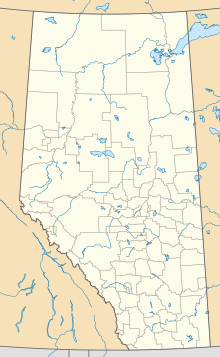Calling Lake | |
|---|---|
Location of Calling Lake in Alberta | |
| Coordinates: 55°12′52″N 113°11′49″W / 55.2144°N 113.1969°W | |
| Country | Canada |
| Province | Alberta |
| Census division | No. 17 |
| Municipal district | Municipal District of Opportunity No. 17 |
| Government | |
| • Type | Unincorporated |
| • Governing body | M.D. of Opportunity No. 17 Council |
| Area (2021)[1] | |
| • Land | 64.62 km2 (24.95 sq mi) |
| Elevation | 595 m (1,952 ft) |
| Population (2021)[1] | |
| • Total | 375 |
| • Density | 5.8/km2 (15/sq mi) |
| Time zone | UTC−7 (MST) |
| • Summer (DST) | UTC−6 (MDT) |
Calling Lake is a hamlet in northern Alberta, Canada within the Municipal District of Opportunity No. 17.[2] It is located on Highway 813 along the eastern shore of Calling Lake, immediately north of Calling Lake Provincial Park. It is approximately 59 km (37 mi) north of Athabasca and 113 km (70 mi) south of Wabasca and has an elevation of 595 m (1,952 ft).
The hamlet is located in the federal riding of Fort McMurray-Athabasca. The hamlet is the seat of the Jean Baptiste Gambler 183 Indian reserve of the Bigstone Cree Nation.
Calling Lake is recognized as two separate designated places by Statistics Canada – Calling Lake (which includes lands on either side of the Jean Baptiste Gambler 183 Indian reserve) and Centre Calling Lake (which is located between the designated place of Calling Lake to the north and Calling Lake Provincial Park to the south).[3]
- ^ a b Cite error: The named reference
2021censuswas invoked but never defined (see the help page). - ^ "Specialized and Rural Municipalities and Their Communities" (PDF). Alberta Municipal Affairs. June 3, 2024. Retrieved June 14, 2024.
- ^ Statistics Canada (2007). "GeoSearch2006". Archived from the original on November 16, 2007. Retrieved January 30, 2010.
